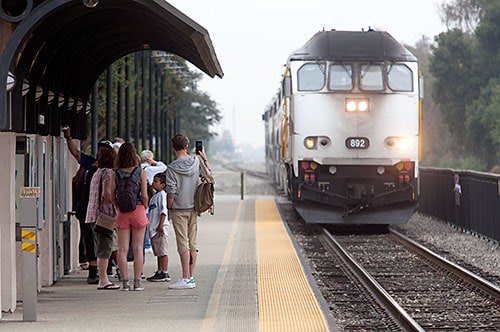Council to consider Claremont train noise

Claremonters have been suffering through extra-loud horns from passing Metrolink trains for months, and the Traffic and Transportation Commission wants the city to do something about it.
On June 23, and at the request of commissioner Zachary Courser, the com
The city council will vote on approving the ad hoc committee at its Tuesday, July 12 meeting. If approved, the council will appoint members to the committee during the meeting, according to Director of Community Development Brian Desatnik. The ad hoc committee would be comprised of three members of the Traffic and Transportation Commission, Mr. Desatnik explained.
The council chamber was full of residents angry about the deafening horns, with some attendees forced to listen from the overflow room. Metrolink representative Sherita Coffelt offered an apology to the commission and the residents in attendance.
“We realize how much this has impacted everyone’s lives and we are profoundly sorry for it,” Ms. Coffelt said. “We’re not going to say it’s not real, it’s a real impact and we hear it every day how much everyone loathes these sounds.”
The offending noise comes from the Burlington Northern and Santa Fe (BNSF) railway engines, which emit a higher-decibel “five-chime” horn, as compared to Metrolink engines, which are built for traveling through residential areas and have a lower “three-chime” decibel horn.
Ms. Coffelt explained that Metrolink is borrowing the BNSF trains for use in the wake of a safety investigation following a fatal 2015 accident in Oxnard, where an engineer was killed when the train collided with a car on the tracks.
The Federal Rail Authority mandates that train decibel levels should be between 96-110. Metrolink engines range from 98-101 decibels, whereas the BNSF engines can top out at 109 decibels, Ms. Coffelt said. Additionally, the BNSF horns are positioned higher on the engines, which allows sound to travel further.
Ms. Coffelt also assured the crowd that the yearlong lease ends in November, and the engines will be phased-out on the San Bernardino line—the region’s busiest—starting in September. Ms. Coffelt says the BNSF trains will be replaced with newer engines that have a lower-decibel horn.
“The goal is to get them off as soon as possible, ” she said.
City Engineer Loretta Mustafa noted that trains are required to sound their horns at least 15 seconds before a crossing—two long, one short, one long—for safety purposes. She presented the possible institution of quiet zones on the stretch of track passing through Claremont as a way to assuage frustrations.
Ms. Mustafa pointed to a similar situation in Florida that saw an increase in traffic accidents of about 150 percent in the aftermath of requiring “quiet zones” without creating additional safety measures. Conversely, she presented an Orange County Transit Authority (OCTA) project that saw quiet zones successfully established throughout Orange County cities.
Train horns could still be sounded during emergencies or when maintenance workers are on the tracks, and Claremonters living along the city’s boundaries could still experience noise, as the trains are allowed to blare their horns the moment they leave the city limits, Ms. Mustafa said.
In addition, once the city establishes quiet zones, it could be liable for any accidents that occur.
To reduce risk along a quiet zone, the city is floating the idea of installing additional safety measures, such as a four-quadrant gate system that completely blocks traffic from crossing while the gates are down.
Ms. Mustafa told the commission that it would cost around $4 million to install quiet zones and safety measures, totaling at around $1.2 million per Claremont crossing. The city is banking on the money coming from an upcoming half-cent tax measure—known as Measure R2—which was recently approved by Metro for the upcoming November ballot.
“A lot of this hinges on the passage of that ballot measure,” Ms. Mustafa said. If the measure doesn’t pass, the city would not have a clear funding source, she noted.
Mr. Courser asked Ms. Mustafa when the quiet zones would be installed if the measure passes. She responded that since the Metro Gold Line extension would be completed by 2023, the safety measures and quiet zones could be installed then, spurring groans from the crowd.
The commission also voted unanimously to work toward a revision of the Federal Train Horn Rule, which could lead to a possible decrease in train-horns sounding when the engines approach a crossing. The FRA is currently reviewing its train horn regulations, and the city wants to pursue changes to the rule during the review process.
During public comment, resident Michael Hines said he measured the decibel level of the incoming trains through Claremont at 115, higher than the threshold outlined by the Federal Rail Authority.
Other commenters questioned the safety requirement for the train horns.
“If this is about safety, then what is the purpose of having a horn that can be heard over a mile away?” resident Eileen Flaxman said. “Are those people who I know who live by the tracks on Indian Hill, are they safer because the horn is waking them up at six in the morning?”
Heather Helming warned that new engines wouldn’t make the situation better for those living near the tracks.
“I don’t want you all to think it’s not going to be a problem anymore,” she said. “Because I live close enough to the train, and I’m a very light sleeper, I’m very confident that even with the new horns, I’m still going to hear them.”
As Mr. Courser was making his motion, he noted that the city should create an actionable plan on how to deal with the noise within the next six months.
“We shouldn’t be asking ourselves whether or not we should have quiet zones; It’s more of a question of when,” he said.
—Matthew Bramlett
news@claremont-courier.com










0 Comments